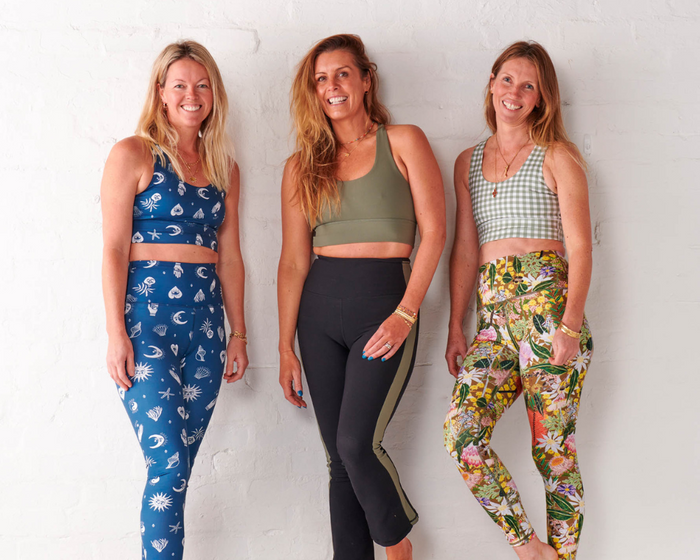For many of us, falling asleep and staying asleep is not as easy as it sounds. When life is busy, emotional or stressful it’s often very difficult to slow the thinking mind, even if the body is tired. When you get quality sleep, it allows the body and brain to repair, reset and restore. When we don’t get enough sleep it can result in poor memory, reduced focus, lowered immunity or mood changes.
Practicing yoga before sleep can:
- Regulate the central nervous system
- Calm the thinking mind
- Relax the body
- Increase mobility and flexibility
- Relieve muscle tension
- Lower heart rate and blood pressure
Reduce anxiety Introducing an “Unwind Before Bed” yoga practice into your bedtime routine can be a powerful tool in assisting quality sleep to avoid those restless nights.

Shop the Kip&Co x Yogi Peace Club collection
To access a more relaxed state we firstly need to connect the mind to the breath, then the body and mind will be united. Yoga poses and pranayama (breath work) help to regulate the central nervous system.
We need to shift of the nervous system from the sympathetic system (fight/flight) into the parasympathetic nervous system (rest and digest), which allows us to reach a relaxed state to prepare for sleep. This can be achieved with a pranayama technique like the suggested below, and a set of restorative yoga poses which include can inversions and forward folds to calm and soothe the nervous system.
Unwind Before Bed Sequence
Here is our yoga guide for a better night's sleep
Pranayama Technique
Begin to drop inwards and rise above your thoughts.
Find a comfortable position on your yoga mat. You could use a cushion to feel comfortable. Breathe in through the nose to a count of three seconds. Hold for two seconds. Release through the nose for to a count of five. Hold for two seconds. Repeat this sequence of breath for a few minutes.
If your thoughts begin to drift, come back to your breath. This will help activate your parasympathetic nervous system, which helps reduce the overall stress and anxiety you may be experiencing. It prepares the body and mind for rest. Once you feel more connected to your body through your breath you can begin to move into some simple yoga shapes.

Shop the Kip&Co x Yogi Peace Club collection
Yoga Poses
Continue with your pranayama breathing as you hold the poses for 5-10 rounds of breath Move the breathe around the body as you deepen your exhale
Childs Pose (Balasana)
- Start on the ground with knees bent and shins pressing down into your mat.
- Fold torso forward.
- You can add a pillow under your forehead if desired.
- Arms can extend forward alongside your ears.
Down Face Dog (Adho Mukha Svanasana)
- From Child Poses come to table top.
- Spread into your palms, pressing down through all four corners of your hands, and turn your toes under.
- Exhale and lift your knees from the floor, at first keeping your knees slightly bent and your heels lifted off the floor.
- Lengthen your tailbone away from the back of your pelvis,
- Lift the sitting bones toward the ceiling.
- On an exhalation, push your top thighs back and stretch your heels toward the floor.
- Press the bases of your hards actively into the floor.
- Keep your head between your upper arms.
- Stay for 4 rounds of breath allowing the blood to move down into your head.
Pigeon Pose (Utthita Eka Pada Rajakapotasana)
- From downward dog bend and bring one knee forward, placing shin on the ground at a diagonal angle.
- You can place a block or pillow under your hip for extra support.
- Extend through your back leg to deepen the stretch in the hamstrings.
- Gently walk your hands forward.
- Lower elbows to rest forearms on the mat.
- Switch sides to repeat on the opposite side.
- Hold each side for 5-10 rounds of breath
Legs Up (Viparitia Karani)
- Lie down on your side, placing a cushion underneath your sit bones.
- Then roll on your back, extending straight legs upward towards the ceiling.
- You can use a block or pillow on the low belly to create a sense of feeling grounded.
- Keep the legs up for 5-10 rounds of breath.
- Try closing your eyes as you lengthen your exhale.
Use this Unwind Sequence before going bed. Once you are in bed and comfortable you could continue your pranayama breathing technique to further enhance your relaxation response. Before you know it, you will be deeply relaxed and drifting off to a peaceful place of rest. If you wake during the night, you can also return to the breath, and if your thoughts or anxieties return, simply rise above your thoughts by moving your focus to the breath and extending your exhale. Good luck and happy restful sleeping!

Shop the Kip&Co x Yogi Peace Club collection
Read more Wellness & Sleep articles on the Kip&Co blog.



